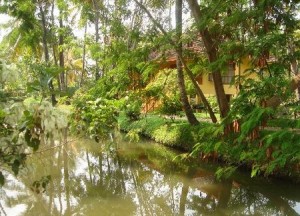





If you want a more permanent stream than that provided by pre-formed stream units or a liner, a concrete watercourse is the only answer. Although more skill will be required than when installing either of the latter, it will not be as great as when constructing a concrete pool, and with care the work should be well within the abilities of the amateur. The concrete mix should be the same as that for a pool.

The method of constructing a stream with concrete does not differ too radically from that of one with a liner. Obviously, the excavation must be 10cm (4in) larger all round than the finished feature to accommodate the thickness of the concrete, and to achieve a watertight construction it is essential to try to lay all the concrete on the same day; even a 24-hour lapse between laying successive mixes will leave a potential point of weakness.
The excavation should be lined with polythene membrane before the concrete is laid. Once concrete laying begins, keep in mind an overall idea of the final stream so that rocks can be placed in appropriate positions to help soften the edges and produce flow patterns within the stream.
Use a fairly stiff concrete mix to prevent it from slumping, and spread it over the contours of the excavation with a trowel. As with a pool, apply about half the thickness of the concrete required and bed wire mesh in it to act as reinforcement. Then add the final layer.
With a concrete construction, it is also vital to consider marginal planting, as the soil immediately beyond the concrete edge of the stream will often be dry. To overcome this problem, create pockets in the concrete that can be filled with soil, which will be kept damp by the passing stream.
The careful positioning of rocks in the bed of a stream can create interesting flow patterns. For example, is barrier of rocks with a gap in the middle will produce fast-moving water, while stones of varying sizes placed across the stream to form a gentle dip will produce a less strident effect. Flat stones tend to produce much smoother water.
1. Having lined the stream bed with polythene, add a layer of concrete. The polythene provides a waterproof barrier and prevents the concrete from drying out too quickly and the surface cracking.
2. Lay the reinforcing mesh and cover with a further layer of concrete, positioning edging stones to provide a neat finish. To obtain a pleasing effect, they should be from the same source.
3. Stones in a stream bed alter the flow of water. The depth of the stone affects the way in which water speed is reduced, those appearing above the water having the greatest impact.
Copyright © www.100flowers.win Botanic Garden All Rights Reserved